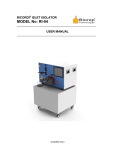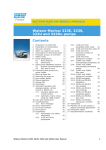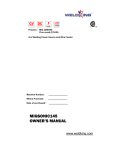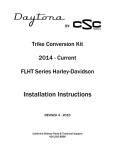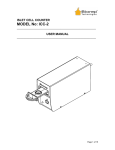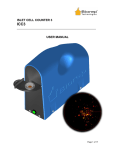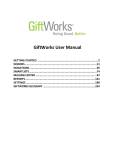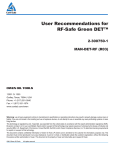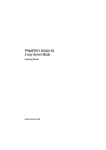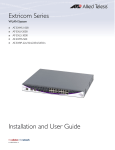Download (MACHINE NAME) - Biorep Technologies, Inc.
Transcript
PERIFUSION SYSTEM MODEL No: PERI-4.2 ______________________________________________________ USER MANUAL ______________________________________________________ © BIOREP 2013 (2) 1 TABLE OF CONTENTS GETTING STARTED.......................................................................................................................... 3 1 1.1 1.2 1.3 1.4 1.5 1.6 SYMBOLS USED IN THIS MANUAL ................................................................................................... 3 MACHINE INFORMATION ................................................................................................................. 3 CONTACT INFORMATION ................................................................................................................. 3 SAFETY INFORMATION .................................................................................................................... 4 SITE PREPARATION .......................................................................................................................... 5 PACKING LIST ................................................................................................................................. 5 2 INTRODUCTION ................................................................................................................................ 6 3 MACHINE PARTS IDENTIFICATION ........................................................................................... 7 4 ACCESSORIES .................................................................................................................................... 9 4.1 4.2 4.3 4.4 4.5 4.6 5 TUBING SET..................................................................................................................................... 9 PERIFUSION CHAMBER .................................................................................................................... 9 PERIFUSION CHAMBER AUXILIARY RACK........................................................................................10 COLLECTION WELL-PLATES ............................................................................................................10 BIO-GEL P-4 ...................................................................................................................................10 FIBERGLASS PRE-FILTERS ...............................................................................................................10 PERIFUSION SYSTEM OVERVIEW ..............................................................................................11 5.1 5.2 5.3 5.4 5.5 6 BASIC PERIFUSION SCHEMATIC ......................................................................................................11 VALVE MANIFOLD .........................................................................................................................12 PERISTALTIC PUMP .........................................................................................................................13 PERIFUSION CHAMBER....................................................................................................................13 COLLECTION TRAY .........................................................................................................................14 PERIFUSION SYSTEM BASICS ......................................................................................................15 6.1 6.2 6.3 6.4 6.5 7 POWER-UP .....................................................................................................................................15 LOGGING IN....................................................................................................................................16 MAIN MENU ...................................................................................................................................17 TEST PAGE .....................................................................................................................................18 SETTINGS........................................................................................................................................20 PERIFUSION OPERATION (PROTOCOL WIZARD) .................................................................21 7.1 7.2 7.3 7.4 7.5 7.6 7.7 7.8 7.9 7.10 8 CHAMBER POSITIONING ..................................................................................................................21 PROTOCOL ......................................................................................................................................21 SYSTEM SETUP ...............................................................................................................................22 CHAMBER SETUP ............................................................................................................................23 PERIFUSION TUBING SETUP ............................................................................................................24 PRIMING .........................................................................................................................................24 CELL LOADING ...............................................................................................................................25 CHAMBER POSITIONING ..................................................................................................................25 TEMPERATURE CONTROL................................................................................................................26 PROTOCOL EXECUTION ...................................................................................................................27 FINALIZING THE EXPERIMENT..................................................................................................29 8.1 8.2 9 10 COLLECTING THE CELLS .................................................................................................................29 CLEANING THE SYSTEM ..................................................................................................................29 REPORT ..............................................................................................................................................30 CUSTOMER SERVICE .................................................................................................................31 2 1 Getting Started WARNING: Please, read this section before unpacking, installing or operating this machine. 1.1 Symbols Used in this Manual The lightning flash with arrowhead symbol, within an equilateral triangle, is intended to alert the user to the presence of dangerous voltage within the machine’s enclosure that may be of sufficient magnitude to constitute a risk of electric shock. The exclamation point within an equilateral triangle is intended to alert the user to the presence of important information in the literature that accompanies the device. This symbol warns of moving parts that may cause personal injury. This symbol is used when two people are needed to do the task. 1.2 Machine Information In the spaces provided below, record the Model and Serial No. located on the rear panel of your machine. Model No. __________________ Serial No.______________________ RETAIN THIS INFORMATION FOR FUTURE REFERENCE. 1.3 Contact Information Biorep Technologies, Inc. th 3225 NW 112 Street Miami, FL 33167 [email protected] www.biorep.com Tel: 305-687-8074 Fax: 305-688-8029 3 1.4 Safety Information WARNING: DO NOT SKIP READING THIS SECTION. PLEASE READ AND OBSERVE ALL WARNINGS AND INSTRUCTIONS GIVEN IN THIS USER’S MANUAL AND THOSE MARKED ON THE UNIT. RETAIN THIS BOOKLET FOR FUTURE REFERENCE. DO NOT REMOVE THE MACHINE’S COVER OR YOU MAY BE EXPOSED TO DANGEROUS VOLTAGE. REFER SERVICING TO QUALIFIED PERSONNEL ONLY. TO REDUCE THE RISK OF FIRE OR ELECTRIC SHOCK, DO NOT EXPOSE THIS DEVICE TO RAIN OR MOISTURE. DANGEROUS HIGH VOLTAGES ARE PRESENT INSIDE THE ENCLOSURE. READ AND UNDERSTAND HOW MOVING PARTS ARE CONTROLLED BEFORE OPERATING THE MACHINE. KEEP YOUR FINGERS AWAY FROM MOVING PARTS; NEGLECTING TO DO SO MAY CAUSE PERSONAL INJURY. READ AND FOLLOW THESE INSTRUCTIONS: 1. Keep these instructions for future reference and heed all warnings stated in this manual. 2. Do not block any ventilation openings. Install the machine in accordance with the manufacturer’s instructions. See Site Preparation in section 1.5 for details. 3. Do not defeat the safety purpose of the polarized or grounding-type plug. A polarized plug has two blades with one wider than the other. A grounding-type plug has two blades and a third grounding prong, which is provided for your safety. If the provided plug does not fit into your outlet, consult an electrician for replacement of the obsolete outlet or contact Biorep Technologies, Inc. at (305) 687-8074. 4. Protect the power cord, the power entry module, and the plug from being walked on or pinched to avoid damaging them. 5. Refer all servicing of the machine to qualified personnel. Servicing is required when the apparatus has been damaged in any way, for example: the power-supply cord or plug is damaged, liquid has been spilled or objects have fallen into the apparatus, or if the apparatus has been exposed to rain or moisture, has been dropped, or does not operate normally for any reason. 4 1.5 Site Preparation This machine is intended to work in a controlled laboratory environment. In order to properly place the machine, please refer to the figure below. The machine has a ventilation opening in the rear, which should not be blocked. A 12.7cm (5.0 in) clearance is recommended between the back of the machine and any obstacle. Bench-space required is 49cm (19.3 in) x 65cm (25.6 in). Figure 1: Site Preparation 1.6 Packing List The following items are included with the purchase of a Perifusion system: Qty 1 12 24 1 1 1 1 1 1 1 15 1 Reference 86610610 IS 3510 PERI-CHAMBER PERI-TUB-12 60985-708 431412 150-4124 CO-A-3 12885T21 62408-940 PERI-NOZZLE 96410-16 Description Power Cord Pump cassettes Perifusion Chambers Two-Stop Tygon Tubing Set (pack of 12) Silicone Tubing (50 ft) Fiberglass Pre-filters (pack of 12) Bio-Gel P-4 Gel (10 grams) Perifusion Chamber Rack Single Hole Punch 96 well-plate Dispensing Nozzle Size 16 Tubing for cooling tray Pack of Clips Replacement O-Rings Table 1: Packing List 5 2 Introduction Congratulations on your purchase of the Biorep Perifusion system. This is the newest generation of a product that has received countless hours of development to include all the features necessary to perform the most controlled and precise stimulated cell secretion experiments in the field. You will not be disappointed with the value and efficiency this machine will bring to your research. The Perifusion system accurately stimulates and collects the secretions of pancreatic islets invitro. Its use has been extended to include the measurement of secretions of differentiated cells derived from pancreatic progenitor stem cells. Coupled to a tandem mass spectrometer, the Perifusion system can help identify molecules secreted during the stimulation of pancreatic islets. The machine accurately controls temperature, flow, stimulus source and sample collection in up to 8 channels in parallel. The Perifusion system is designed to execute pre-programmed protocols that can last for hours and require several sample trays. This User Manual is intended to be used by scientists, researchers, and technicians who have received training in cell perifusion methods and technologies. This document contains the necessary information for installing and operating the machine. However, it is not meant to provide scientific guidance on perifusion protocols. Any perifusion protocols encountered in this manual will be solely for the purpose of illustration of machine operation and should not be interpreted otherwise. 3 Perfusion 4 Isolation 2 Organ Transportation 5 Purification 1 Donnor 8 Transplant 6 Perifusion 7 Cell Transport Figure 2 Perifusion System in the islet isolation process 6 3 Machine parts identification Figure 3: Perifusion system, side view Figure 4: Perifusion system, front view 7 Figure 5: Perifusion system, back view 1. Removable source holder 2. 32 (8 x 4) valve manifold for source handling 3. 12 Channel peristaltic pump (Main pump) 4. Temperature control inlet/outlets (x6) 5. Perifusion chamber 6. Sample collection tray 7. Alarm buzzer 8. Tray cooling diaphragm pump 9. Power cable 10. Incubator cover 11. 12” Touch-Screen 12. E-Stop 13. Orbitor Enable (Optional Add-On) 14. Nameplate 15. USB 2.0 Port 1 16. USB 2.0 Port 2 17. RJ45 LAN Port 18. Power Entry Module 8 4 Accessories A complete set of accessories is included with the machine. For ordering additional or replacement accessories please consult our webpage www.biorep.com or contact one of our sales representatives at (305) 687-8074. 4.1 Tubing Set The Perifusion tubing set delivers the stimulus to the cell chamber while minimizing dead volume. The perifusion tubing set is made out of 2 types of tubing: A- Connection tubing, which is for the perifusion fluid handling system (source-manifold, manifold-pump, pump-chamber); and B- the peristaltic pump tubing, which provides the precise resolution needed in perifusion experiments. A set of each type is included with this machine. Item A B Description Silicone Tubing; 0.040in ID, 0.085in OD Two-Stop Tubing (Tygon R-3603) (orange-green); 0.015in ID, 0.035in WT; Reference 89068-462 PERI-TUB-12 Table 2: Items Included in the Perifusion Tubing Set 4.2 Perifusion Chamber The Perifusion chamber is where all cell reactions will take place. Substances will be delivered through the inlet tube, cells contained in the chamber will react to the substances, and secretions will come out the outlet tube for collection. A new system includes 16 perifusion chambers. 1- Inlet tube 2- Top cap 3- Top O-Ring 4- Cell chamber 5- Bottom O-Ring + Filter 6- Bottom cap 7- Outlet tube Figure 6: Perifusion Chamber 9 4.3 Perifusion chamber auxiliary rack The auxiliary rack is included with every Perifusion system to assist in the preparation of the Perifusion chambers. The rack can hold up to 8 chambers at a time for cell loading outside the machine. This allows the scientist to do the preparation away from the machine in a more comfortable position. Figure 7: Perifusion Chamber Rack 4.4 Collection well-plates The collection well-plate is where the cell secretions and the perfusate are collected for analysis. The Perifusion system was designed to work with standard 96 well-plates, and now has the ability to use high capacity, deep well plates for longer experiments. Figure 8: Collection Well-plate 4.5 Bio-Gel P-4 The Bio-Gel P-4 polyacrylamide beads are used at the time of Perifusion chamber setup. They are used to sandwich the cells inside the chamber to contain them and prevent clogging of the filter. To prepare the beads solution, use a 50ml conical test tube and add 5ml of beads + 40ml of the buffer solution. Let the solution sit overnight prior to a perifusion experiment. Figure 9: Bio-Rad polyacrylamide beads 4.6 Fiberglass pre-filters A fiberglass filter sheet is included with every perifusion system. A hole puncher (included) is used to make round cut-outs of the filter sheet to place inside the perifusion chamber during its set-up. The purpose of this filter is to retain the chamber contents while allowing the flow of the perfusate. Figure 10: Hole Punch 10 5 Perifusion system overview 5.1 Basic Perifusion schematic The following schematic shows the basic functional elements and stages of the Perifusion system. Potential users should become familiar with all the components of the system before attempting to operate the machine. Figure 11: Basic Perifusion Schematic 1. SOURCES: Up to eight different test solutions can be used as sources in a single experiment. These sources can be administered either manually by the user or automatically by the machine through the valve manifold. Sources are contained inside the enclosure’s temperature controlled environment. 2. VALVE MANIFOLD: An automated valve manifold handles the source selection for each channel. The manifold has 8 input channels (1, 2, 3…8) and four output channels A, B, C and D. Each output channel is tripled, for a total of 12 output connections. A detailed description can be found in section 5.2. 3. MAIN PUMP: A high precision, 12- channel peristaltic pump moves the test compounds from the source, through the manifold, to the Perifusion chambers and out to the well plate. 4. PERIFUSION CHAMBER: The Perifusion chambers hold the cells to be stimulated. The input to each chamber is the source selected by the manifold for its respective channel. The output will contain the secretions and metabolites to be collected on the well plate. Up to eight Perifusion chambers can be used in parallel. 5. TEMPERATURE CONTROL: All the test sources are housed in the same incubator enclosure as the Perifusion chambers to provide a controlled temperature environment for the entire process. A multi-point circulation design ensures temperature uniformity within 1ºC around the Perifusion chambers. 6. COLLECTION: The perfusate is collected in a well plate for further analysis. The collection tray moves automatically accordingly to the number of active columns (Perifusion chambers) and the 11 pre-set sampling rate. The collection tray can hold deep and standard 96 well plates; be sure to place the included spacer adapter inside the tray to use it with standard plates. 7. REFRIGERATION: The collection tray can be refrigerated to avoid degradation of the analytes in the perfusate during experiments. This is done by a dedicated diaphragm pump. 5.2 Valve Manifold The valve manifold was designed to automate the selection of the stimulus. Manual source changing is not only time consuming for the user, but it also increases the potential for artifacts on the results. Manual source changing requires the user to pause the machine to avoid drawing air into the system, but cell metabolism cannot be paused! Cells will continue to metabolize and, when flow is resumed, a “spike” of metabolites will be generated at the output. Minimizing this problem was a priority at the time of developing the new Perifusion system. The result was a self contained, 32 valves, 8-in to 4-out manifold. The manifold can change the source for every channel “on-the-fly” (milliseconds), eliminating the need for pausing the system. It also eliminates the need for external sources requiring a separate heater; the sources can be housed inside the machine, allowing for a better temperature control. In conjunction with the ability to perform automated protocols, the valve manifold provides a hands-off solution from start to finish of a Perifusion experiment. The user can now leave the machine unattended and have the certainty that source changes will be made flawlessly every time. Figure 12: Valve Manifold Understanding the valve manifold is key for a proper experiment setup. Inputs are located at the bottom of the manifold block, starting with input 1 at the left (see fig. 12). Sources should be connected to the input ports according with this numeration. There are four triplicate output channels (A, B, C, D) located in the front of the manifold. Each triplet represents an output channel, starting with channel A at the top. Manifold states are represented by the letter and number combination “CHANNEL-SOURCE” for each of the four channels: An, Bn, Cn, Dn, where n = 0-8, depending on the selected source (“0” represents a closed channel). 12 Example: The manifold state: A2, B3, C8, D0, means that the three outputs of channel A will output source 2, the three outputs of channel B will output source 3, the three outputs of channel C will output source 8 and the three outputs of channel D are Inactive/closed. Automated protocols will have a manifold state defined for each step. A detailed description of protocol creation can be found in section 7.2. 5.3 Peristaltic pump The sources are pumped from their containers through the open valves of the manifold by the main pump. The main pump is a 12 roller, high precision peristaltic pump, capable of handling up to 12 channels simultaneously, providing accurate and identical dispensing across channels. Figure 13: Peristaltic Pump (Only 8 channels shown) The main body of the pump (1), is fixed to the machine chassis. The special tubing (3) setup is facilitated by individual cartridges (2). Cartridges snap in and out of the pump by pressing on the release lever (4). A detailed description of tubing setup can be found in section 7.5. 5.4 Perifusion chamber Sources delivered by the pump will react with the cells inside the perifusion chamber. The cells are contained inside the chamber within a gel bead matrix. A fiberglass filter is used as a bottom layer before the output. Secretions will come out the outlet tube for collection in the well-plate. The internal volume is 275 µL. The chamber is translucent to allow visualization of its contents. It is designed to fit a micro-centrifuge tube for easy cell recovery. This is important at the time of data normalization. A detailed description of the chamber setup for an experiment can be found in section 7.4. 13 1. Top cap 2. O-ring 3. Cell chamber 4. Fiberglass filter 5. Bottom cap 6. Micro-centrifuge tube Figure 14: Perifusion Chamber and collection tube 5.5 Collection tray Figure 15: Collection Tray The collection tray (1) holds and positions the well-plate (2) for automated collection of the perfusate and cell secretions according to programmed time intervals. The collection tray can be used in a Horizontal or Vertical configuration with respect to the positioning mechanism (3). In addition, the collection plate can be refrigerated by circulating fluid through the available ports (4). The Perifusion system features a new deep collection tray that allows the use of large capacity 96 well plates. To use standard capacity well plates, insert the included spacer adapter into the tray. When inserting the well-plate on the collection tray, make sure that well A1 is in the position shown on Figure 15. This will ensure that the dispensing sequence will start at this point, avoiding any confusion at the time of analysis. 14 6 Perifusion System Basics Control and operation of the Perifusion system is done through the touch-screen interface. This type of interface eliminates the need for an external keyboard or mouse device and provides a visual and intuitive interaction with the user. The operator should familiarize himself/herself with the different screens, features, and controls of the interface before attempting to operate the machine during an actual perifusion. Anyone who will operate and/or supervise the use of this machine should read and understand this section in its entirety. This machine has been designed with alarm features that will help the user identify and correct potential problems. Alarm messages will be displayed at the bottom of the screen. A detailed description of the different alarms can be found later in this manual. 6.1 Power-Up The machine’s main power switch and fuse-box are located on the back of the machine, above the power entry module. Connect the power cord (provided in the accessory box) to the module and then plug it into a 115/230 VAC outlet depending on your location. The red box in the module displays the voltage rating intended for your machine. Figure 16: Power Module This screen will appear after a successful system boot-up. Touch anywhere on the screen to continue. Figure 17: Power-up screen 15 6.2 Logging In The Login Page allows you to Log into your password protected user account. The user account saves your protocols, reports, and the preferences of your experiments; it also saves time by prefilling some frequently used fields during the experiment process and during reporting. The first step is creating a user account. To create a new user account, press the Add User Button. When the “Add User” button is pressed, the “New User Account” fields on the right of the screen will be enabled. Upon clicking on any field a pop-up keyboard will appear. Enter a unique username and password using the keyboard and press “Accept”. Click Save to create the user. Now you will be able to find name on the drop down list left. The next time you do a experiment, just select your the list, enter your password “Login”. your User at the top Perifusion user from and press Figure 18: Login page 16 6.3 Main Menu Figure 19: Main Menu Once logged in, you will arrive at the Main Menu page. On this page you can start an experiment, via the “Protocol Wizard”; configure the settings of the machine, or manually control the different sub-systems of the machine via the “Test Page”. In this page you will also see the User account, the Software Version installed in your perfusion machine, and the machine Status Bar at the bottom. The Status Bar will display any alarms or important messages related to the function of the machine. You can also end the session from this page either by logging out of your user account or by turning the system off. Please do not turn the machine off from the power entry module before being prompted to do so. 17 6.4 Test Page Figure 20: Test Page The best way to get acquainted with the different sub-systems of the Perifusion machine is by playing around in the Test Page. You can test the alarm buzzer by pressing the “Test Buzzer” button, or confirm the proper sensing of the tray orientation by looking at the icon on the top right. This icon should change when the tray is moved between “Landscape” and “Portrait” orientations. MOTION: The motion controls manipulate the position of the tray by enabling direct access to the motors. Simply touch any direction arrow to move the tray in the desired direction. You can control the speed of the movement by changing the “Velocity (Jog)” value. An X,Y position indicator is provided in case you need to record the position value for reference. Press HOME to return to the starting position. Figure 21: Motion Controls 18 TEMPERATURE: The temperature systems can be tested by these controls. The “HEATER” button enables the heater and the convection fans. The incubator PV (Present Value) will be displayed below. The tray cooling pump can be turned on by pressing the “Tray Pump” button. The tray temperature will be displayed below Figure 22: Heater controls FLUIDICS: The fluid handling manifold is the most valuable sub-system for automating a Perifusion experiment. It is composed by the precision peristaltic pump, and the 8 to 4 manifold. The pump can be tested by assigning a value to the “Pump Flow-rate” box. The state of each of the 32 individual valves on the perifusion can be manually changed by touching the corresponding LED indicator on the graphical array. An open valve is represented by an ON indicator. It is not recommended that you open all valves at once. Figure 23: Valve controls At any point, press the BIOREP logo to return to the MAIN MENU Figure 2418: Return to Main Menu 19 6.5 Settings Figure 25: Settings page Before starting your perifusion experiments you have the option of customizing parameters relating to the temperature alarms, tray handling and protocol execution timing. ALARMS: The alarms are listed in the left hand side of the page. They can be de-activated in case of a special case need, where a particular alarm is bothersome, but it is recommended that all alarms remain active for protection of the machine. TRAY HANDLING: Use this control to define which type of tray you are using in your experiments (Deep or Standard). The “Orbitor Power” switch relates to the Orbitor robot accessory (Sold separately). This option will be grayed out if your machine is not equipped with the Orbitor. Please refer to the Orbitor manual for further instructions on operating Orbitor enabled machines. TIMING: The timing controls are used for special protocol execution sequences. ACTION REQUIRED ALARM: If the user does not want or can’t use the automatic manifold, the “ACTION REQUIRED ALARM” should be activated. This causes the machine to alert the user when any action is required to continue, such as manually changing the solution or changing the tray. The user can define how much time ahead of a required action will the machine sound the alarm. This will give the operator a chance to prepare for the change and minimize idle time. The machine will automatically PAUSE execution when action is required. After the action is complete the user must un-pause the machine manually to resume operation. SKIP FIRST ROW: When this option is enabled, the machine will automatically start in row 2 of every tray used in a protocol. This option is used when the first row of the tray will be post-filled with a control sample by the user. 20 7 Perifusion Operation (Protocol Wizard) Continuing our effort to make Perifusion experiments more streamlined, and reduce the chance of error during setup, we have developed a “Wizard” type interface to set-up and run your experiments. The wizard will guide you step by step through the setup of the machine, setup of the sample, execution of your protocol, reporting of the results, and even post-experiment maintenance of the machine. Enter the wizard from the Main Menu screen by pressing the Protocol Wizard button (see 6.3). 7.1 Chamber positioning On the first screen of the wizard you will tell the machine how many chambers you plan to use on your experiment. You can use any number from 1 to 12. Select the chambers to be used by changing the value on the top field. The Green indicators under the chamber icons will light up, confirming your choice, and reminding you the positions of the chambers in the chamber rack inside the incubator. As a general rule, chambers should be placed on the rack, starting from the right-most position and adding more chambers to the left. Chamber number one (1) will always be the left-most chamber. Figure 26: Chamber positioning page Misplacing the chambers will cause the collection sequence to fail. Please make sure the chambers are numbered and located on the rack as shown by the wizard. 7.2 Protocol On this screen you will be able to select or create a protocol for the machine to run automatically. A list of previously created protocols will be shown as a list on the left pane. The right pane shows the contents of the protocol. A protocol is divided into a series of steps, which are identified by the rows of the table. Each Step has the following attributes: Rep# is the times the step is consecutively repeated before changing to the next step. Time (sec) determines the duration of each repetition (Rep) of the step. Figure 27: Protocol page 21 This means that a step with Rep# = 5 and Time = 20secs will dispense the selected solutions for 20 seconds, then move the collection tray to the next row of wells and dispense the same solutions for another 20 seconds, and so on for 5 consecutive well rows. So in general, the total dispensing time in a step would be the product of Rep# and Time, and distributed evenly in consecutive well rows equal to Rep#. The next column in the protocol is the Flow-rate (µL/min) in micro-liters per minute. This determines the rate at which the solutions are supplied to the cells during the step. This parameter controls the speed of the peristaltic pump. All channels will have the same flow. The next four columns (A, B, C, D) relate to the automatic fluid handling system (see section 5.2). In these fields you can assign the solution (1 to 8) for each of the channels. If you are not using one of the channels, assign a zero "0" to the solution field. The next and last column is the Pause option. This parameter will determine if the machine pauses after a step is finished. This is an advanced option, where you need to perform a manual operation between the steps. For all conventional Perifusion experiments, this option should be set to NO. On the top right of the screen you will find a # of Plates. This number will tell you the number of well plates required to complete the protocol. This will help you have all the plates in hand to avoid unnecessary delays. Creating a Protocol To create a protocol, click on the "NEW" button. Click "ADD STEP" button to add a step to your protocol. A row filled with "X" will appear. Replace all the X with your protocol values. No X can be left on the protocol. Repeat the process to add more steps. Assign a name to the protocol and click "SAVE" to store your protocol in the machine's memory for future use. You will now see the name of the new protocol displayed on the left pane. Loading a Protocol Biorep can provide you with a spreadsheet template that will allow you to create protocols from the comfort of your office. Simply fill out the template as you would on the Perifusion touch-screen and save the protocol onto a USB stick as a tab delimited text file. On the perifusion system, plug the USB stick to one of the ports in the back of the machine; Click the "LOAD" button on the wizard and navigate to the txt file you created. The protocol will be loaded into the wizard interface and will be ready to save and execute. 7.3 System setup Before an experiment can be performed, the machine has to be properly set-up and prepared. The basic steps to complete are the following: • • • • • Chamber setup Tubing setup Source priming Perifusion chamber cell loading Pre-heating the incubator/ Cooling the sample tray 22 Some of these steps may be overlapping. Please read the entire setup instructions carefully before attempting to do it on your machine. For further assistance please contact customer support. 7.4 Chamber Setup Prepare the perifusion chambers as shown in the wizard screen: 1. Use the included hole-puncher to cut the necessary number of filters from the fiberglass pre-filters. (You will need 2 filters per chamber, so multiply the number of chambers from step one of the wizard by two to determine this number) 2. Place a circular fiberglass filter (2) inside the bottom cap (1) bore. 3. Place an o-ring (3) on top of the filter. Ensure no wrinkles are present on the filter. 4. Tighten the bottom lid (1) on the chamber body (4) 5. Place the top o-ring (5) inside the chamber body bore (4). 6. Connect the short section of the perfusion tubing set (8) to the outlet tube of the bottom cap. Push it all the way to the plastic. This segment should be identical for all chambers 7. Connect the stainless steel nozzle (9) to the bottom of the short tubing segment and place the finished bottom section on the auxiliary rack 8. To set up the top section, connect one end of the three-stop tubing (orange-greenorange) (7) segment to the inlet tube of the top cap 9. Repeat for all chambers being used. You should end up with two halves as shown in Figure 2 (of the screen) Figure 19: Perifusion Chamber Assembly Once you have both halves of the chamber pre-set, you can proceed to the tubing setup and to the cell loading stage. The top half will be used in the tubing setup and the bottom half will be loaded with cells. Once both stages are complete and the system is primed, the chamber can be closed and will be ready to run an experiment. 23 7.5 Perifusion Tubing Setup The tubing setup can be divided in two main parts: The source side and the chamber side. This section will assume that the chamber has been set up as shown in section 7.4. Prepare the tubing as described in the wizard screen Source side- Number your input source(s) (1) from 1 to 8 (max) and connect them to the corresponding port on the valve manifold (refer to figure 12) with a 12in section of 0.04in ID tubing (2). Tubing lengths are not critical on this side of the manifold. Chamber side- Connect a 3/4in long segment (4) of 0.04in ID tubing to the corresponding output of the manifold and to the free end of the three-stop tubing (5) (the other end should be connected to the chamber top cap(7). Insert the three-stop tubing in the pump as follows: 1. The tubing (5) is inserted in the cassette (6a) by sliding it through the groove. 2. The orange colored detent (5a) on the manifold side should mate with the notch in the back of the cassette. Figure 2920: Tubing setup 3. The tubing should be longer on the chamber side than on the manifold side 4. When the tubing is secure, align the guide (6b) onto the pump bar and push the cassette until the lever (6c) locks in place. IMPORTANT: Ensure all lines have the same tubing section lengths on the chamber side (after the manifold (sections: 4, 5, 7)). These sections make up the “dead volume” of the line. For best results, it should be minimized and kept as even as possible between lines. 7.6 Priming After the tubing is properly setup and the sources have been connected, the system should be primed to remove any air in the system. This was an involved process in previous versions of the perifusion machine that is now performed automatically by pressing PLAY button. The machine automatically performs the priming sequence depending on the active protocol. You will be able to monitor the valve sequence followed by the machine as it performs the priming. The progress will be displayed on the bottom bar. Figure 30: Priming page 24 7.7 Cell loading When the system is completely primed and ready for the chamber to be attached: 1. Place the bottom half of the assembled perifusion chamber(s) (8) on the rack (7) with the bottom cap (9) and filter in place facing down. 2. Using a pipette, add 100µL of the bead and buffer suspension (5) to each chamber. Please see Appendix A for bead suspension preparation instructions 3. When fluid starts dripping from the nozzles (10), clamp the tubing to retain the solution. 4. Add the cell sample (6) 5. Add another layer of the bead suspension (5), making sure to top-off the chamber 6. Start the pump slowly at approximately 100µL/min until solution starts dripping from the top caps (4) 7. Screw each chamber to its corresponding cap (4) by carefully turning the chamber body (8) and quickly remove the clamp from the bottom outlet 8. Place each chamber (8) and nozzle (10) in their designated locations in the machine rack 9. Stop the pump. All valves will close automatically Figure 3121: Cell Loading 7.8 Chamber positioning Care must be taken when positioning the perifusion chambers on the perifusion chamber rack inside the incubator. Chamber placement starts from the right-most position with the last chamber, and then subsequently filling positions to the left until the first chamber is placed. The first chamber should be the leftmost chamber. This is of critical importance to the proper functioning of the experiments; a misplaced chamber will deliver in the wrong well or even outside the tray! 25 Please see the following examples: Figure 32: Two active chambers 7.9 Figure 33: Four active chambers Temperature control Once the system has been prepared, the incubator must be heated up to the desired temperature and the collection tray must be cooled down to preserve the analytes. Follow the on-screen instructions. Heating 1. 2. 3. 4. Close the incubator cover Press the "HEATER" button to enable the heater and turn on the fans Allow approximately 20 minutes for the incubator "temp stable" LED to turn on For better results and better temperature distribution, do not open the incubator cover during the experiment. To re-fill the sources, run a tubing section from the source to the outside of the incubator through the channels of the removable source tray. IMPOTANT: If the incubator cover needs to be opened for any reason, turn the heater OFF. This will ensure that when the incubator cover is closed, there is no temperature overshoot. Cooling 1. To set up the tray cooling, fill a container with coolant. The coolant can be chilled water or a mixture of water and alcohol 2. Connect 1/8" I.D. silicone tubing as shown on the figure 3. Prime the diaphragm pump using a siphon or syringe 4. Press "TRAY PUMP" to turn the pump ON. Once the tray pump is enabled, the button will turn blue WARNING: Do not run pump dry! Figure 3422: Cooling 26 7.10 Protocol execution When you reach this screen the cells should be in the chambers, the manifold and should be primed with the input solutions and the temperature of the incubator and tray should be at their set points. On this screen you can start your Perifusion experiment by hitting the PLAY button. The flow rate, manifold state, and movement of the tray will be automatically handled by the machine. The machine will only require your input in special cases (as described in previous sections), or when the machine requires manual change of the sample tray. This screen is primarily used, as its name suggests, to monitor experiment progress. Figure 3523: Protocol monitor The Monitor screen can be divided in 5 functional sections: EXECUTION CONTROLS Figure 3624: Execution Controls These controls allow you to START, PAUSE and STOP the protocol execution at any time. Starting the execution of a protocol requires two steps. The first time you press the PLAY button, the machine will “HOME”. This will allow you to load a 96 well plate into the sample tray. Press the PLAY button once more to begin the protocol. 27 . ALARMS AND INDICATORS Figure 3725: Alarm Controls This section of the protocol monitor displays the settings selected for the protocol, like the type of 96 well plate (standard or deep); it also displays if the SKIP FIRST ROW option was selected. When the Orbitor robot is present, the indicator will display if it is enabled. The speaker icon can be pressed to mute and un-mute the audible alarms. TEMPERATURE Figure 3826: Temperature controls. These controls allow you to control and monitor the temperature settings of the system. The HEATER button controls the incubator heater. The current incubator temperature is displayed on the Incubator PV (Present Value) indicator. The TRAY PUMP button controls the cooling pump for the sample tray. The tray temperature is displayed on the Tray PV indicator. FLUIDICS Figure 3927: Valve Controls The changes in the fluid handling systems can be monitored on-screen, by means of a graphical valve map. The valve map will display the open valves at any given time during the protocol. The pump flow rate can also be monitored. TIMING Figure 4028:Timing indicators. These indicators will provide information related to the timing and progression of the experiment. Since the experiment has many chronological “levels”, these indicators will help you identify where you are in your protocol. The first level locates you in the timing of the repetition. Rep Time shows the elapsed time of the current repetition, and Total Rep Time shows how long that repetition is. The level below shows you where you are within the STEP. Rep # identifies the current repetition out of the total repetitions of the current step (Total Reps). The third level shows which step is currently being executed (Step #) out of the total number of steps (Total Steps). Finally the last level shows you which plate is currently being dispensed on. The bar at the bottom shows you graphical progress of the entire experiment. 28 8 Finalizing the Experiment 8.1 Collecting the cells 1. Top cap 2. O-ring 3. Cell chamber 4. Fiberglass filter 5. Bottom cap 6. Micro-centrifuge tube Figure 41 Perifusion Chamber and collection tube To remove the beads and islets slur from the chamber, remove the bottom cap and introduce the cell chamber into the micro-centrifuge tube. Remove the top cap and add 1 ml of Hank’s balanced salt solution (HBSS) from the top so the slur goes down into the micro-centrifuge tube. Centrifuge at 300g for 5 minutes and discard the supernatant. Lyse the cells with the beads. Centrifuge again and assay the supernatant for DNA. There should be no beads in the supernatant. 8.2 Cleaning the system After the protocol has been executed successfully, the system must be thoroughly cleaned, not only to ensure your system lasts longer, but most importantly, to eliminate all residues from the fluidic system, that may cause the system to malfunction, or inadvertently affect the results of future experiments. The wizard includes a cleaning step to help you do this in the most effective manner. Follow the on screen instructions to perform a thorough cleaning. The cleaning sequence has 4 steps: 1- Flush with de-ionized water. To do this, take all input tubing to the manifold and change the source to draw up from a de-ionized water container. 2- Sanitize with a mixture of 9 parts distilled water and 1 part bleach 3- Rinse once more with de-ionized water 4- Dry by drawing air (remove input tubing from the manifold) Figure 4229:Cleaning page During the cleaning sequence the timing and valve sequence will be done automatically. The wizard will pause between each of the four steps to give you time to change/remove the sources. 29 9 Report After the cleaning sequence you will be directed to the Report page. Fill-in experiment specific information required to generate the automatic report: 1. Fill in the Experiment name. 2. Assign unique names to the solutions used in the experiment. The color key will be used in the report to generate a map. 3. Assign the number of chambers used for each of the output channels. 4. Press GENERATE REPORT. Figure 4330: Report page Figure 4431:Sample report An experiment report will be automatically generated. The report includes user and sample information, and protocol specific information, such as the temperature profiles, the solutions used, and the timing of the experiment. The most useful section of the report is the Well-Plate maps, color coded according to the solution used. The plate maps are in tabular form, representing the 96 well plate (8 x 12), and each cell represents an individual well. Each cell contains two pieces of information. The color indicates which solution was used, and the number indicates the STEP. This map is useful when cross-referencing the data to subsequent processing such as ELISA. 30 10 Customer Service If you encounter any problems, please contact customer support at: Biorep Technologies, Inc. 3225 NW 112th Street Miami, FL 33167 [email protected] www.biorep.com Tel: 305-687-8074 Fax: 305-688-8029 31 APPENDIX A Buffer Preparation Buffer Solvent: De-ionized water Buffer Solute Ingredients/ Proportions: 32 Bead Suspension Preparation • • • • • Add beads to 5ml mark of a 50ml conical Add 40ml of buffer solution. Prepare bead-buffer suspension at least one day before the experiment to allow beads to absorb buffer. Keep the bead-buffer suspension refrigerated (4℃) Bead suspension may be kept refrigerated for up to 4 weeks Bead Suspension Use Follow these instructions before using the bead suspension in a perifusion chamber preparation: • • Warm bead suspension to 37℃ using an incubator or water bath. Do not add cold bead suspension to cells, since this may adversely affect your experiment. Agitate conical thoroughly before pipetting bead suspension to add into perifusion columns. This ensures that approximately even number of beads are present in each column. 33

































